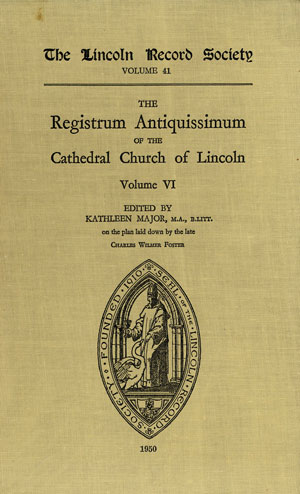
The Registrum Antiquissimum is the earliest complete cartulary of Lincoln Cathedral. It was written mainly in the third decade of the thirteenth century. It was prepared from the original texts, many of which have not survived. Canon Foster noted that its writer ‘copied with literal accuracy. As a consequence his texts may be relied upon’.
The period originally proposed to be covered extended from the year 1061, the date of the only pre-Conquest document to the death of Bishop Hugh of Wells in 1235. However it was found convenient, and indeed necessary, to print many documents which are later in date.
The charters illustrate the history of an English secular cathedral church in respect of its organisation and personnel, its endowments and its franchises. The Introduction notes that the texts of 7,826 charters have survived of which 4,200 are the original documents. There are 1,073 charters in the Registrum Antiquissimum. Volume I contains the texts of 308 documents.
The documents in the Registrum Antiquissimum include charters of the possessions not only of the common of the canons, and of the prebends, but also of the see of Lincoln. These possessions lay dispersed throughout the diocese of Lincoln which, as constituted by William the Conqueror, stretched, until the middle of the sixteenth century, from the Humber to the Thames. It comprised the counties of Lincolnshire, Leicestershire, Northamptonshire, Rutland, Huntingdon, part of Hertfordshire, Bedfordshire, Buckinghamshire, and Oxfordshire. Outside the diocese, the charters relate to land in London and in the counties of Berkshire, Derbyshire, Hampshire, Kent, Nottinghamshire, Surry, and Yorkshire. But it is for the history of the Northern Danelaw that the Lincoln charters are of first-rate importance.
Adapted from the Introduction
This volume contains two hundred and one charters relating to the wapentakes of Calcewath, Candleshoe, Bolingbroke, Hill, Gartree and Horncastle. The plates for Volumes V and VI of The Registrum Antiquissimum are in Volume 42.
Adapted from the Preface.
The period originally proposed to be covered extended from the year 1061, the date of the only pre-Conquest document to the death of Bishop Hugh of Wells in 1235. However it was found convenient, and indeed necessary, to print many documents which are later in date.
The charters illustrate the history of an English secular cathedral church in respect of its organisation and personnel, its endowments and its franchises. The Introduction notes that the texts of 7,826 charters have survived of which 4,200 are the original documents. There are 1,073 charters in the Registrum Antiquissimum. Volume I contains the texts of 308 documents.
The documents in the Registrum Antiquissimum include charters of the possessions not only of the common of the canons, and of the prebends, but also of the see of Lincoln. These possessions lay dispersed throughout the diocese of Lincoln which, as constituted by William the Conqueror, stretched, until the middle of the sixteenth century, from the Humber to the Thames. It comprised the counties of Lincolnshire, Leicestershire, Northamptonshire, Rutland, Huntingdon, part of Hertfordshire, Bedfordshire, Buckinghamshire, and Oxfordshire. Outside the diocese, the charters relate to land in London and in the counties of Berkshire, Derbyshire, Hampshire, Kent, Nottinghamshire, Surry, and Yorkshire. But it is for the history of the Northern Danelaw that the Lincoln charters are of first-rate importance.
Adapted from the Introduction
This volume contains two hundred and one charters relating to the wapentakes of Calcewath, Candleshoe, Bolingbroke, Hill, Gartree and Horncastle. The plates for Volumes V and VI of The Registrum Antiquissimum are in Volume 42.
Adapted from the Preface.

Volume 41 The Registrum Antiquissimum of the Cathedral Church of Lincoln. Volume VI.
Editor Kathleen Major M.A., B.Litt. on the plan laid down by the late Charles Wilmer Foster
Date For the year ending 31st August 1944
Publication Date 1950
Size 255 x 155 mm
Language The documents are in Latin with summaries in English
Printer The Hereford Times Limited, Hereford
Content Preface, 3 pages
Contents, 5 pages
Abbreviations and Notes, 3 pages
List of Charters, 6 pages
Addenda et Corrigenda, 1 page
Registrum Antiquissimum documents 1748-1948, 167 pages
Appendix I The Date of the Second Seal of the Chapter, 2 pages
Suggested descent of the family of Scoteni in the 12th and 13th centuries, 1 fold out page
Appendix II The Family of Scoteni, 16 pages
Index of Persons and Places, 32 pages
Index of Counties and Countries, 4 pages
Index of Subjects, 8 pages
Description See the Description for Volume I, LRS Volume 27.
This volume contains two hundred and one charters relating to the wapentakes of Calcewath, Candleshoe, Bolingbroke, Hill, Gartree and Horncastle. The plates for Volumes V and VI of The Registrum Antiquissimum are in Volume 42.
Adapted from the Preface.
Editor Kathleen Major M.A., B.Litt. on the plan laid down by the late Charles Wilmer Foster
Date For the year ending 31st August 1944
Publication Date 1950
Size 255 x 155 mm
Language The documents are in Latin with summaries in English
Printer The Hereford Times Limited, Hereford
Content Preface, 3 pages
Contents, 5 pages
Abbreviations and Notes, 3 pages
List of Charters, 6 pages
Addenda et Corrigenda, 1 page
Registrum Antiquissimum documents 1748-1948, 167 pages
Appendix I The Date of the Second Seal of the Chapter, 2 pages
Suggested descent of the family of Scoteni in the 12th and 13th centuries, 1 fold out page
Appendix II The Family of Scoteni, 16 pages
Index of Persons and Places, 32 pages
Index of Counties and Countries, 4 pages
Index of Subjects, 8 pages
Description See the Description for Volume I, LRS Volume 27.
This volume contains two hundred and one charters relating to the wapentakes of Calcewath, Candleshoe, Bolingbroke, Hill, Gartree and Horncastle. The plates for Volumes V and VI of The Registrum Antiquissimum are in Volume 42.
Adapted from the Preface.